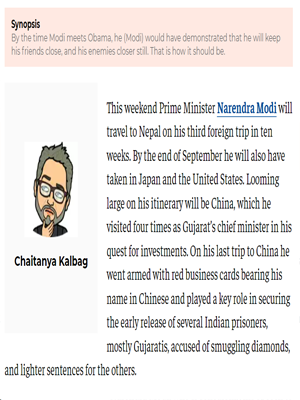Four weaknesses India needs to overcome to build a strong foreign policy
[The Ecomonic Times]
Published date: 11th Mar 2019
This weekend Prime Minister Narendra Modi will travel to Nepal on his third foreign trip in ten weeks. By the end of September he will also have taken in Japan and the United States. Looming large on his itinerary will be China, which he visited four times as Gujarat’s chief minister in his quest for investments. On his last trip to China he went armed with red business cards bearing his name in Chinese and played a key role in securing the early release of several Indian prisoners, mostly Gujaratis, accused of smuggling diamonds, and lighter sentences for the others.
Modi’s early visits as prime minister to Bhutan and Nepal and his overtures to Bangladesh are part of a careful strategy, not unlike in the Chinese game of Go, to gain elbow room in a neighbourhood that Beijing has worked hard to coopt. That is why India is stepping so carefully on issues like Chinese violations of the Line of Actual Control in Ladakh and Arunachal Pradesh, or the runways and military infrastructure that China has apparently built on Myanmar’s Coco Islands, adjacent to the Andamans. After all it was George Fernandes, defence minister in the Atal Behari Vajpayee cabinet, who said in May 1998 that China was encircling India with access to ports and surveillance posts in Sri Lanka, Pakistan, Nepal and Myanmar. Fernandes said China posed a greater threat to India than Pakistan. That was just eight days before India detonated three nuclear devices at Pokharan, stunning the world and sending a clear message to the P5-the nuclear-armed permanent members of the U.N. Security Council.
There is a discernible quickening of pace in China’s courtship of Modi.
Vice-President Hamid Ansari travelled to Beijing at the end of June for the 60th anniversary anniversary of the Panchsheel Treaty (violated just eight years after it was signed when China fought a brief war with India) and met both President Xi Jinping and Premier Li Keqiang. Xi told Modi when they met at the BRICS summit in Fortaleza, Brazil, in mid-July that the neighbours were strategic partners and not rivals.
Significantly, Xi urged progress on the Bangladesh-China-India-Myanmar Economic Corridor. It is not surprising that despite his campaign noise on illegal immigration from Bangladesh, Modi was quick to despatch Foreign Minister Sushma Swaraj to Dhaka for early talks, and India responded very mildly when a U.N. tribunal awarded Bangladesh with nearly 20,000 sq km of territorial seawater in the Bay of Bengal in early July.
At the same time, Modi is savvy enough to know that relations with Washington and Tokyo are key counterweights to Beijing. On Wednesday, US, Indian and Japanese warships completed a week of the annual Malabar maritime exercises in the Western Pacific. Japanese Prime Minister Shinzo Abe has been eager to welcome Modi to Tokyo in pursuit of his ‘confluence of two oceans’ theory where India keeps a sharp eye on the Indian Ocean and Japan on the Pacific. And it is no coincidence that US Secretary of State John Kerry and Commerce Secretary Penny Pritzker are in Delhi for the fifth US- India Strategic Dialogue today – July 31 is also the deadline for global trade talks in Geneva that a newly stubborn India is threatening to scuttle.
The trade facilitation agreement brokered by the World Trade Organization in Bali last year is seen by the Modi administration as hobbling India’s freedom to subsidise its farmers through minimum support prices – a policy that has built abundant food stockpiles. India is the lone holdout at the Geneva talks, and if it caves in, the Bharatiya Janata Party is bound to pay a steep price in rural votes in key states like Maharashtra and the Hindi belt. If the Geneva talks collapse, India could face isolation in other trade forums. Undaunted, Modi’s government has also put on hold the field trials for 13 genetically modified crops.
The BJP government’s foreign policy and ideology intersect in interesting patterns with realpolitik and national interest. To look outward more confidently, we have to overcome four weaknesses. One, despite its size and growing influence India has one of the world’s smallest corps of diplomats; we need more envoys and less politesse. Two, for nearly all of the UPA’s decade in power we had to suffer a string of vapid and decorative foreign ministers who pushed a spineless agenda; we need to see and hear Sushma Swaraj more. Three, we cannot seem to decide whether it is time to give our non-aligned fence-sitting a deep, deep burial – we should. And four, we have toyed with but shied away from projecting ourselves as a muscular regional power armed with nuclear weapons and a blue-sea navy; we need to stop being a tentative sparring partner to more aggressive pugilists. By the time he meets President Barack Obama at the end of September, Modi will have demonstrated that he will keep his friends close, and his enemies closer still. That is how it should be.






